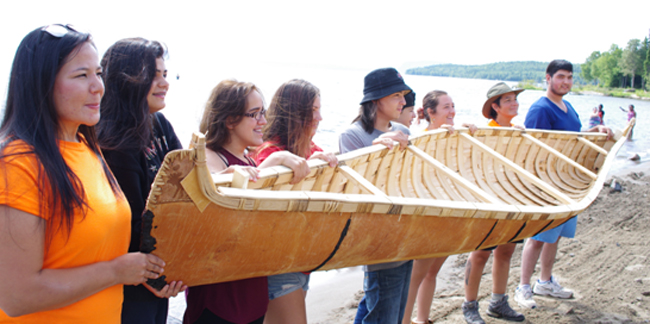Birch bark canoe built and launched in Fort William

By Rick Garrick
FORT WILLIAM FIRST NATION – A group of Anmeki Wajiw (Mount McKay) students from Fort William First Nation recently built and launched a birch bark canoe in August.
“It’s a really cool project — it brought all the kids together,” says Rachelle Johnson, one of two supervisors of about 15-20 students who worked on the canoe. “After you see the process and after you see a little bit of the work that’s done, you feel proud of what you have accomplished.”
The students and supervisors took turns paddling the 15-foot canoe in Lake Superior’s waters during the Aug. 13 launch ceremony at Sandy Beach, near Chippewa Park.
“It’s amazing,” says Gail R. Bannon, Fort William’s culture and recreation coordinator. “Look at what they did — it’s all their work, their sewing. They put every rib in and carved each around the gunnels. They did it all.”
Bannon says the community is planning to build a bigger canoe next year.
“We’re hoping it will be over 20 feet,” Bannon says.
The Anmeki Wajiw students gathered the materials for the canoe, including birch bark, spruce roots and spruce gum. It was built on Mount McKay under the guidance of birch bark canoe builder Darren Lentz.
“We went to get roots, we collected the bark, we peeled the roots ourselves,” Johnson says. “There were a few parts of the canoe that were pre-prepared for us, but other than that we did it almost all by ourselves.”
Johnson says the students enjoyed learning how to make the birch bark canoe, noting that Lentz “knew so much” about building the traditional watercraft. The students worked on the canoe for about two hours a day, four days a week, for three weeks.
“It was fun just to learn how to build the canoe,” says Daniel Morrison, one of the Anmeki Wajiw students. “Two years ago we built a wigwam, so it was basically the same — gather roots, bark, make the panels. I love learning this stuff — eventually when I get great at it, I would love to build my own canoe on my own.”
Crystal Morrison, Daniel’s mother, is proud of her son for participating in the project and learning how to build a birch bark canoe.
“It’s something that I won’t forget and he won’t forget for many years to come,” Crystal says. “You can see all the happy faces and the joy around everyone. It is nice to know that this is being done still and that our youth are willing to partake and learn these (traditional activities) and pass it on to the next generation.”
Fort William Councillor Michele Solomon says the project was a “really great initiative” to revitalize some of the community’s land-based activities.
“It’s an exciting day for the young people who participated in the making of this canoe,” Solomon says.
Fort William Chief Peter Collins was impressed with the work the students did on the canoe.
“It’s really good to see our young people starting to look at our culture, looking at our traditions, looking at the way we used to travel,” Collins says. “It gives them strength, it gives them belonging, gives them a place to be, it helps them spiritually and guides them in the right direction.”


